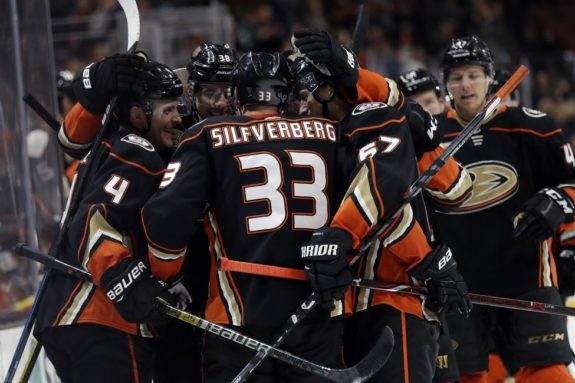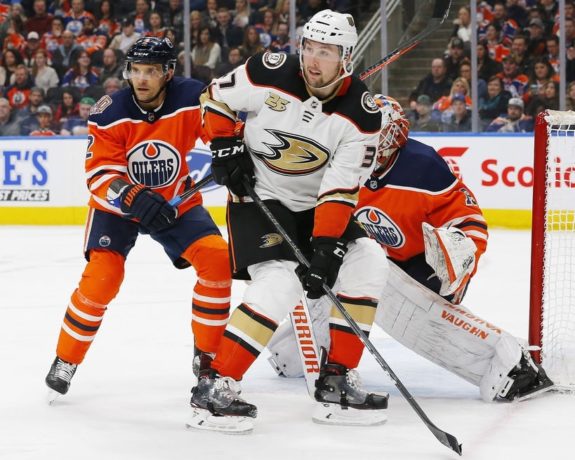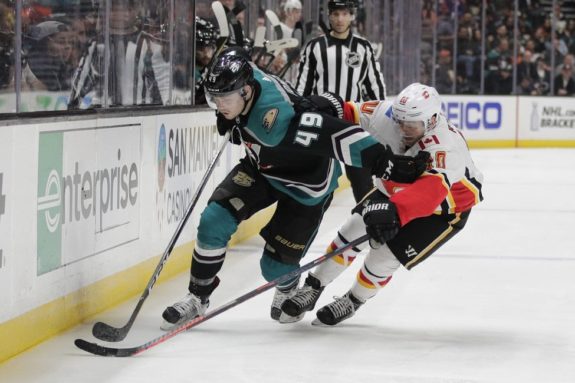Introducing The Hockey Writers’ Countdown to Puck Drop series. From now until the puck drops on the 2019-20 NHL’s regular season on Oct. 2 when the Toronto Maple Leafs host the Ottawa Senators, we’ll be producing content that’s connected to the number of days remaining on that particular day. Some posts may be associated with a player’s number, while others will be connected to a year or length of time. We’re really excited about this series as we take you through the remainder of summer in anticipation of the return of NHL hockey.
Only 33 days remain before the NHL drops the puck on the 2019-20 season. With 33 in mind, let’s look back at the trade that gave the Anaheim Ducks franchise its current No. 33, Jakob Silfverberg. It’s been just over six years since the Ducks acquired Silfverberg from the Ottawa Senators along with a first-round pick and Stefan Noesen for local boy Bobby Ryan. In that time, it’s clear the trade itself was a win but has general manager Bob Murray done everything in his power to maximize its benefit after the fact?
Ryan Relief
The Ducks drafted the local boy, Ryan, No. 2 overall — behind Sidney Crosby — in the 2005 NHL draft. Ryan did not fail to impress during his time with the Ducks. He topped 30 goals every full season he played in Anaheim except for the lockout-shortened 2012-13 season.
However, Ryan found himself the subject of frequent trade rumors during the latter stages of his time in Anaheim. That combined with his $5.1 million cap hit increased Murray’s motivation to trade the talented forward with Ryan Getzlaf and Corey Perry’s $8 million-plus per year extensions ready to begin in 2013-14.

The day finally came July 5, 2013, when Murray sent Ryan to Ottawa in return for Silfverberg, Noesen, and what became the 2014 No. 10 overall pick.
Ryan Shines for Senators in 2017 Playoffs
The Ryan trade benefitted both sides to an extent, although it took longer to make a difference for Ottawa than it did Anaheim and the benefit for the Senators wore off much faster. Ryan never reached the production he achieved in Anaheim. He never again approached 30 goals and never cracked the Senators top three in regular-season scoring.
However, in 2016-17, the Ryan trade at least partially paid the Senators dividends when he scored 6 goals and added 9 assists for 15 points helping push Ottawa to an unexpected Eastern Conference Final appearance. They came within a double-overtime goal of reaching the Stanley Cup Final. Ryan contributed three game-winning goals including two in overtime.
Unfortunately for the Senators, they’d already dug their own grave when it came to the overall value of the Ryan trade. Two seasons earlier they inked the 27-year-old Ryan to a whopping seven-year $7.25 million per year extension that won’t expire until he’s 35.
Last season, Ryan actually achieved his best production since 2015-16 with 42 points, but at $7.25 million with a no-movement clause and a modified no-trade clause, he’s overpaid and not going anywhere.
Silfverberg Brings Two-Way Consistency
On the Ducks’ side of the trade, Silfverberg has been a source of consistency in both the offensive and defensive zones, clutch scoring and leadership. He’s hovered near 20 goals and 40 points every season in Anaheim except his first and he’s a fixture on their penalty kill and power play.
Like Ryan, Silfverberg has twice been a factor during deep Ducks playoff runs. He tied Perry for second in playoff scoring during the Ducks’ 2015 run to Game 7 of the Western Conference Final when he scored 4 goals and added 14 assists. He repeated that performance in the Ducks 2017 Western Conference Final run with 9 goals and 5 assists.

Though their motivation had more to do with salary cap implications and a souring relationship with the team, they traded a player who seemed to be in his prime. Fortunately for them, his production cratered. In return, Silfverberg gave them consistent production and a cheaper contract (he was still on his entry-level deal) to go with a better two-way game.
Ritchie’s Future with Ducks Will Be a Factor
A trade is a trade and whether it’s a win or not should be judged strictly on the effect that the players included in it had on their teams. With that in mind, it’s a win.
But trades, especially trades with big-name players, create splashes that ripple through franchises for years. It’s part of the reason why “trade trees” can be so mind-blowing.
The Ryan trade continues to have implications for the Ducks and not the Senators. Thanks to the very generous and now overpriced contract that the Senators signed Ryan to, he will probably finish his career in Ottawa. He will be the only branch on that part of the tree.
The Ducks got more than just Silfverberg. They received Noesen and the Senators’ first-round pick, which became No. 10 overall. The Ducks waived Noesen in 2017, but the first-round pick still has implications for Anaheim.
That pick became Nick Ritchie. Ritchie, at first, looked like he was on his way to becoming the power forward the Ducks had hoped he was when he scored 14 goals and added 14 assists in his first full NHL season.

In the two seasons since, he hasn’t quite met expectations but still holds enough value to potentially bring back another talented NHL player in a trade. The fact that the Ducks got a No. 10 overall pick in addition to Silfverberg strengthens the case that the Ryan trade was a win, but that continues to hinge on what happens to Ritchie.
Why Did the Ducks Extend Silfverberg?
Last season, the Ducks missed an opportunity to move on from Silfverberg and continue to accumulate assets during their current rebuild or “retool.”
Last season, when the Ducks were working on an extension with Silfverberg, they were in middle of an all-time nosedive. They slid far enough out of the playoff picture that, for the first time in six seasons, they were sellers rather than buyers approaching the trade deadline.
Rather than adding more assets for the player, who was arguably at his most valuable, Murray signed Silfverberg to a five-year $5.25 million per season extension that will expire when Silfverberg’s age matches his jersey number, 33.
It’s easy to see why Murray likes Silfverberg so much. His offensive ability led him to a career and team-high in goals with 24. His two-way play made him the team’s most consistent player and one of the lone bright spots in an otherwise miserable season.
With Perry bought out, Getzlaf approaching the end of his career, and Ryan Kesler and Patrick Eaves suffering from injuries that may have already ended theirs, Anaheim’s core of forwards has a potential leadership void on the horizon.
Perhaps Murray wants Silfverberg and Adam Henrique to fill that void on the offense, and serve as examples for Max Jones, Max Comtois, Trevor Zegras, Sam Steel, Isac Lundestrom and Troy Terry.

Maybe his value with the team outweighed what he would’ve brought back in a trade.
Silfverberg’s Trade Value
That value may have been higher than it’s ever been and ever will be. Left wing Matt Zuccarello, who scores more total points on average than Silfverberg, but is also nearly three years older, fetched the New York Rangers the No. 49 overall pick this draft and third-round pick at the 2020 draft.
Gustav Nyquist, another Silfverberg comparable brought the Detroit Red Wings the 2019 No. 60 overall pick and a 2020 third-rounder.
After finally firing Randy Carlyle last season and taking over for him behind the bench, Murray told the media,
“We’re not rebuilding — we’re retooling.”
(from “Ducks GM Bob Murray will coach and evaluate players,” – The Orange County Register – 2/12/19).
Keeping productive veterans like Silfverberg and Henrique keeps their floor from sinking too low during their “retool,” but how productive will Silfverberg be at age 33?
More importantly, will his $5.25 million cap hit be a hindrance by the time Terry, Steel, Comtois, Jones, Lundestrom and Zegras have new, presumably more expensive contracts if they are still around?
How much will that hurt the Ducks from adding established players to their roster once they’ve returned to their winning ways?
Acquiring Silfverberg and the other assets in the trade for Ryan clearly was a win for the Ducks. Like most trades, however, the book hasn’t entirely closed on the transaction. Murray still has Ritchie to use as a trade asset and it remains to be seen what will happen to him. It will also depend on how long Silfverberg stays productive. Once we know those answers, the book will finally be closed on the Ryan trade.
All stats from hockey-reference.com